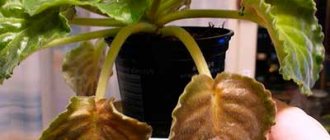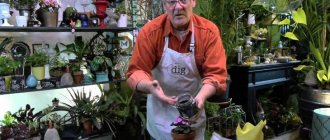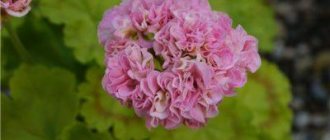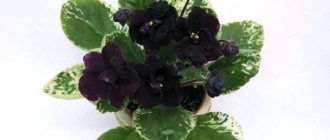Foreign varieties often fascinate with their charming simplicity. So the Buckeye Seductress violet bred by Hancock is not to be missed . The variety has distinctive features that lie not in the size of the flowers, but in their quantity.
But in order to get a plant that will meet all the parameters of the variety, you need to follow the rules of care and know what appearance it is striving for. After all, without knowing the external parameters, it is impossible to assess compliance. And if you make mistakes in care, there is a risk of getting a diseased socket. Next you can see the photo and description of this variety.
Where to put
Like all other varieties, Buckeye Seductress violet prefers bright light, but does not tolerate direct sunlight.
Therefore, it is best to place it on the north window. Sometimes Buckeye Seductress is placed on the east or west, after closing the glass with thick curtains. The air in the room in which Buckeye Seductress is supposed to be grown should be quite humid and warm. Most often, experienced indoor plant lovers install this elite violet in the kitchen. In this room, and especially during cooking, the Buckeye Seductress has ideal conditions in terms of heat and humidity.
Under no circumstances should this plant be installed in a draft. Otherwise it will definitely start to hurt. In order for the violet rosette to always have a neat shape, the flower should be turned to the light with the other side about once every two weeks.
Properties
Name
- Original: B u ckeye Sed u ctress
- Transcription: B a kai Sed a ktres
- Translation: Seductress
Registration
- Breeding: P. Hancock
- Year: 07/13/2006
Socket
- Socket type: standard
Flower
- Flower size, up to: 4 cm
- Flower shape: star
- Terry: terry
- Main color: lavender
- Color type: two-tone
- Border: double
- Other features: greenish lower petals
Foliage
- foliage color: medium green
- foliage type: simple
- foliage shape: oval, pointed, quilted
- reverse of sheet: silver
- leaf edge: jagged edge
- variegation: bordering (Tommy Lowe)
Conditions
A window facing north or east is ideal for violets. Its leaves always stretch towards the light, so you need to regularly turn the pot so that the bush grows in width evenly. Violets also bloom very well in daylight. If the plant has thick leaves and long stems, it means it is not receiving enough sunlight. Low-growing bushes with short stems and small, wrinkled leaves, on the other hand, receive too much sun.
To be healthy and bloom, violets need 14 to 16 hours of bright indirect or artificial light every day. Plants should also be kept in darkness for 8 hours. These flowers are picky about temperature. At night it should be kept in a room between 18 and 21 degrees; during the day the temperature may be higher. If the windows are not insulated enough, you may need to move the flowers to a shelf on a cold night.
Violets darken and wilt if it gets too cold, but they don't like extreme heat either. Air conditioning, higher humidity and the optimal amount of light are what the plant needs. Flowers need high humidity in order for them to bloom. Professionals use humidifiers and trays of pebbles and water.
Description of Buckeye Seductress violets
The Buckeye Seductress violet pleases with its solemn appearance. During the flowering period, it is covered with a thick cap of peduncles, the leaves stand out with a beautiful white fringe. The quality of flowering and the intensity of color depend on the conditions that the grower creates for the flower.
Description of the variety
The lilac-blue flowers of this violet are not large, but they appear on the bush in great abundance. Among the characteristics of the variety, one can highlight the wide green border of the flower. Depending on the subspecies, the shade can be either light purple or quite bright and saturated. When a flower ages, it begins to deteriorate from the middle, then the petals slowly dry out.
The foliage is formed in large rosettes and is a rich shade of green. Even during the dormant period, when the violet has only leaves, it looks elegant. After planting, the first flowering appears a year later. This variety does not need a lot of light, but it must be distributed evenly.
You can place the pot under a lamp with artificial light; it will be enough for year-round flowering.
Conditions
A window facing north or east is ideal for violets. Its leaves always stretch towards the light, so you need to regularly turn the pot so that the bush grows in width evenly. Violets also bloom very well in daylight. If the plant has thick leaves and long stems, it means it is not receiving enough sunlight. Low-growing bushes with short stems and small, wrinkled leaves, on the other hand, receive too much sun.
To be healthy and bloom, violets need 14 to 16 hours of bright indirect or artificial light every day. Plants should also be kept in darkness for 8 hours. These flowers are picky about temperature. At night it should be kept in a room between 18 and 21 degrees; during the day the temperature may be higher. If the windows are not insulated enough, you may need to move the flowers to a shelf on a cold night.
Violets darken and wilt if it gets too cold, but they don't like extreme heat either. Air conditioning, higher humidity and the optimal amount of light are what the plant needs. Flowers need high humidity in order for them to bloom. Professionals use humidifiers and trays of pebbles and water.
It is important to prevent droplets from appearing on the leaves, otherwise problems with fungal infections will begin.
Priming
The soil pH should be at 5.8-6.2. It needs to be well drained as these plants are sensitive to soggy soil. Ready-made mixtures are an ideal solution, since all the proportions in them are met by the manufacturer. A grower can make his own soil by mixing equal parts peat moss, perlite or vermiculite and river sand. But you can’t take sand from the beach, because it is harmful and contains many substances that will simply kill the violet. Before use, the soil must be sterilized by heating to 82°C for 30 minutes.
Fertilizers
The standard fertilizer formula for violets is 14-12-14 NPK. Most experts recommend using completely water-soluble fertilizers so you can water and fertilize at the same time. It is better to apply fertilizing more often at a lower concentration than to burn the roots.
Watering
Loose potting soil with a high organic content is a good growing medium for violets. Experts disagree on the best way to water these colorful plants, which prefer evenly moist soil. You can moisten the soil from above, below, placing the pot in a bowl of water or using a wick.
Reproduction
Beginners are always advised to use leaves or flower stalks as material for propagating violets. The whole point is that in this way you can create as many plants as you like, while maintaining the properties of the mother plant. The process is very simple.
- First, the knife or blade that will be used to make the cut is processed. Use alcohol or a dissolved activated carbon tablet.
- Shoots from the third row are suitable as good planting material. Leaves that are too young do not take root, old ones have a woody stem, which also does not give roots well.
- Perlite is considered a better germination medium because it retains moisture without creating high humidity conditions.
- After planting and watering, the leaf can be hidden under a plastic cup or film, so it will germinate faster, but you need to ventilate it every day.
- In a few weeks a rosette will appear, when there are about four leaves, you can transplant it into another pot with soil.
Description of the variety
As a rule, “Isadora” is a violet of light pink or white shades with more contrasting hot pink, purple or lilac spots.
The violet of this variety belongs to the Gesneriev family - Saintpaulia. The petals of violet buds are fleshy, round in shape and soft - covered with villi.
Story
“LE-Isadora” was bred by breeder from Ukraine Elena Lebetskaya.
This variety, like almost all varieties from this breeder, is a very delicate and graceful flower. Its distinctive features are its fairly large size and a coating on the petals that makes the flowers seem like velvet. Elena Lebetskaya herself described the flowers as semi-double. Interesting! Single and semi-double white stars with pink prints, studded with fuchsia fantasy touches. Green smooth leaves. (Description by E. Lebetskaya)
Bloom
The bud opens for a long time, remaining in the form of a rose for a long time. Full disclosure occurs in about two weeks.
A green border can be seen on a newly opened bud, which disappears over time.
The flowers are on average 4-5 centimeters in diameter. There are from three to six buds on the peduncle. Despite the fact that the peduncles are short, they do not have a strong build.
Socket
The flowering period is very long. The rosette is standard, medium in size with even stripes of leaves. One of the best types of propagation is cuttings. This method increases the fertility of violets. Being a type of fantasy violet, they can also have sports. To avoid this, it is recommended to bring several rosettes at once before flowering.
Leaves
The leaves are large and may droop when there is plenty of light. Foliage color varies between medium green and dark green. The type of foliage is simple, heart-shaped, quilted.
The reverse side of the foliage has a pink tint, and the edges of the leaves seem to be slightly torn, as they have jagged edges. Variegation is not typical for this variety.
Interesting! Since the variety is fantasy, this variety may have sports.
Peculiarities
This variety has delicate lavender flowers with a wide white border and lower greenish petals. On some flowers, the green from the lower petals extends to the edge of the white border, giving the flowers a spring freshness. Double flowers resemble roses. The flowers are not very large, up to 4 cm. There are up to 7 flowers on one peduncle.
According to the description, the socket is a large standard one. But there are lines with a neat little rosette. If there is insufficient lighting, the petioles may stretch slightly and the leaves may rise upward. There are also lines with sockets that require less lighting. When there is too much light, such rosettes have leaves that hug the pot. The leaves of the rosette are medium green, with beautiful cream variegation.
The variety is very original and recognizable. This variety sports white flowers and slightly scalloped foliage. It was registered with AVSA in 2012 under the name Buckeye Serenity. The variety is easy to care for. Propagates well from leaf cuttings. It grows quickly, blooms often and abundantly. Very suitable for beginner violet lovers.
Description of the variety
The lilac-blue flowers of this violet are not large, but they appear on the bush in great abundance. Among the characteristics of the variety, one can highlight the wide green border of the flower. Depending on the subspecies, the shade can be either light purple or quite bright and saturated. When a flower ages, it begins to deteriorate from the middle, then the petals slowly dry out.
The foliage is formed in large rosettes and is a rich shade of green. Even during the dormant period, when the violet has only leaves, it looks elegant. After planting, the first flowering appears a year later. This variety does not need a lot of light, but it must be distributed evenly.
Where did the variety come from?
This unusual elite violet was bred quite recently by American breeders (P. Hancock), but has already managed to take its rightful place on the windowsills of domestic indoor plant lovers. The main emphasis of US botany when developing new varieties today is not on the size of violet flowers or the shade of their petals, but on the shape of their rosette, trying to ensure that it is as neat and symmetrical as possible. With Buckeye Seductress they succeeded to the fullest. The rosette of this violet is absolutely even, elegant and very compact.
What does garden violet mean?
People have been admiring the delicate charm of violets for almost two and a half millennia, but they began to be purposefully grown and propagated to decorate gardens and parks relatively recently:
Violets have recently begun to be grown in gardens.
- In European countries, violet has been known as a garden plant since the beginning of the 16th century;
- In Russia - since the 18th century.
INFORMATIVE! Violets propagated for growing near human habitations are united by flower growers into a conventional group of garden violets. The synonymous series of this group, in addition to the name “Garden Violet”, includes the names “Viola”, “Pansy” and simply “Violet”.
Reproduction
Beginners are always advised to use leaves or flower stalks as material for propagating violets. The whole point is that in this way you can create as many plants as you like, while maintaining the properties of the mother plant. The process is very simple.
- First, the knife or blade that will be used to make the cut is processed. Use alcohol or a dissolved activated carbon tablet.
- Shoots from the third row are suitable as good planting material. Leaves that are too young do not take root, old ones have a woody stem, which also does not give roots well.
- Perlite is considered a better germination medium because it retains moisture without creating high humidity conditions.
- After planting and watering, the leaf can be hidden under a plastic cup or film, so it will germinate faster, but you need to ventilate it every day.
- In a few weeks a rosette will appear, when there are about four leaves, you can transplant it into another pot with soil.
Growing conditions
Despite the unpretentiousness of the “Isadora” violet, it is necessary to devote a lot of time to caring for it, as it has some features. Experienced breeders share their experience and recommend paying close attention to the issue of watering and fertilization. By following some simple tips you can grow a healthy and beautiful flower.
The soil
The soil for each variety of violets is selected individually. First of all, it must be loose, breathable soil with good moisture holding capacity. For this variety, a suitable substance includes high-moor peat, vermiculite, perlite, charcoal and antibacterial swagnum moss. The latter is very important as a disinfectant and antifungal property.
Temperature
Temperature is an important component of proper care. For violets of any variety, temperature means a lot. “Isadora” is a very heat-loving plant; it is recommended to keep the room temperature at 23 degrees Celsius.
Temperatures below are strictly prohibited. At night, temperatures above 18 degrees will be acceptable for violets.
Lighting
The lighting must be correct.
If you want the flower to be healthy and beautiful, you need to provide “Isadora” with at least 12 hours of light baths. But at the same time, it is necessary to exclude direct sunlight from hitting the plant if it is standing near a window, as they can simply burn it. The first sign of improper lighting in the room where the violet is located may be yellowing of the leaves. It occurs due to overheating of the plant. In this case, we can only recommend one thing: do not place the plant on the sunny side, not only during the flowering period, but also after it.
Pot
It is necessary to select a pot for a plant with skill. Since the rhizomes will be in the upper layers, it means that a container with low stems and a diameter of about 10 cm is acceptable for the plant. If the container is smaller, the plant will be cramped, this will provoke its poor development. As well as regular flower replanting.
Watering
Watering requires special attention. “Isadora” is recommended to have nutritious and loose soil, saturated with oxygen and moisture. But the plant cannot tolerate excess moisture, as well as stagnant water, which can cause diseases in violets.
Paying attention to this, it is recommended to pour drainage into the pot with the plant. For drainage, pebbles or expanded clay may be suitable, but the best option would be a mixture containing:
- 1/2 - leaf soil;
- 1/5 – sand;
- 1/3 – peat.
Attention! Violets do not tolerate overwatering; this can lead to the death of the flower.
Home care
Every gardener who has a swamp violet in his gallery should know how to provide proper care for a wild plant at home. Particularly important care details are:
- watering and fertilizing;
- thermal and light conditions;
- features of transplantation and propagation of the variety, and so on.
Conditions of detention
Like all other Saintpaulias, Marsh loves partial shade, so it is best to place such a plant on windows that are located on the southwest or southeast side of the building.
Violets love a temperate climate, which means the air humidity should not be higher than 50%.
Proper watering and fertilizing
It is very important to remember that watering for Saintpaulias is not always the same. And, if in the warm season the soil needs to be moistened at least 3-4 times a week, then in the autumn-winter period the flowers need enough moisture from 1-2 waterings per month
IMPORTANT! In order for a flower to actively grow and develop, it must be regularly fertilized, various fertilizers and mineral fertilizers must be applied. It is most effective to use liquid fertilizers, which are added to water for irrigation. You need to “feed” the plant with fertilizer once a month, instead of just watering
You need to “feed” the plant with fertilizer once a month, instead of just watering.
Lighting and air temperature
For violets, it is best when they are in partial shade or occasionally receive bright light from direct sunlight. Such lighting is permissible from the beginning of daylight until 10 am, as well as from 16.00 until the end of daylight. The rest of the time the flower should be in partial shade.
The permissible air temperature for violets in the room should not exceed 20-25 degrees Celsius. At elevated temperatures, the soil dries out twice as quickly and there is a risk of not only drying out the foliage in the plant’s rosette, but also destroying the root system, that is, the death of the flower.
The maximum permissible decrease in temperature should not be less than 16 - 18 degrees. Otherwise, development may stop.
Temperature is very important for bog violet.
Effect of air humidity
Air humidity for Saintpaulias should not exceed 65%, since too much air can lead to rotting of the root system and death of the flower. In this case, the air should not be too dry so that the Saintpaulia does not dry out.
ADVICE! You can increase air humidity using trays of water placed around the perimeter of the room.
What kind of soil does the plant prefer when growing at home?
At home, you can grow violets either in purchased Saintpaulia soil or in a soil mixture you prepare yourself. To do this, it is recommended to mix in equal parts:
- black soil;
- sand;
- tree moss;
- drainage.
The main taboo for growing swamp violet at home is black soil. This variety grows wild and therefore develops better in drier soil.
Pruning and hygiene
To avoid infection by pests and viral diseases, gardeners need to carry out regular hygiene procedures for the plant.
Trimming dry leaves and shoots is necessary to avoid attracting harmful insects.
In addition, pruning helps maintain the attractive appearance of the plant.
Diseases and insects
Growing violets is an enjoyable hobby for many people. Plants will bloom almost constantly provided proper care and timely pest control
By paying close attention to potting soil, humidity, watering and fertilizer, the grower will be rewarded with healthy plants and beautiful blooms.
Violets can be affected by fungal, bacterial and viral diseases, which often lead to the death of the flower. The best remedy for problems is fungicides. Insecticides help against insects, but bacterial infections cannot be treated.
Aphids, bugs, mites, thrips are the insects that a plant grower has to deal with most often. They can be removed with a decoction of onion peels or just a warm shower. Root rot requires more attention from the florist than powdery mildew or rust.
How to grow a violet from a leaf is described in the following video
Winter care
The Buckeye Seductress violet plant came to us from the south, and therefore needs additional lighting in the cold season. If possible, it is worth purchasing a small fluorescent lamp for the flower. But you can simply turn on a chandelier or lamps in the evenings in the room where the flower is installed. Buckeye Seductress should not be watered too often in winter. In any case, you should not allow water to stagnate in the pot. Otherwise, the roots of the violet will definitely rot by spring.
The variety does not tolerate low temperatures well. If it is cold on the windowsill, it is better to remove the flower from it to a more suitable place. In winter, the air in rooms is usually very dry. Therefore, under the pot with violet it is worth placing a tray with expanded clay and water.
Buckeye Seductress is a violet, the photo and description of which are described in detail in this article. This plant is quite unpretentious. It is no more difficult to care for than any other variety. His appearance is, in fact, very original and elegant. With timely watering and fertilizing, as well as choosing the right place, Buckeye Seductress will certainly please its owners with spectacular long-lasting flowering.
Reviews
Tatiana Maksimovskaya. I really liked the variety Buckeye Seductress (P. Hancock) - it is not capricious from cuttings to flowering, it grows quite quickly, at the very first flowering of a young, not yet fully formed rosette, it bloomed with a cap without any “tricks”. The flowers last quite a long time - in a presentable form - a little more than a month. The flower looked like a rose.
Tatiana Lysikova. The variety is wonderful. I have a socket with a compact socket (there is a large standard with a large socket and a compact standard with a small socket). Grows on a wick in natural light. It blooms very often and profusely, even in winter it bloomed several times, but not very profusely. Beautiful delicate flowers that last a long time. A beautiful variegated, even rosette. There are no problems in growing, the cutting produces many children, the starter blooms early. The variety is easy to care for and can be recommended to beginning violet lovers.
Watering
Like any other Saintpaulia, “Isadora” loves regular but moderate watering. It is recommended to moisten the soil 2 times a week in the warm season, and during the plant’s dormant period (from October to February), the number of waterings can be reduced to one. Excess moisture, as well as its deficiency, has the most detrimental effect on violets, leading to wilting of leaves and lack of flowering.
For irrigation, use soft water at room temperature. If you use tap water, you must first let it sit for 3-4 days.
Watering should be extremely careful - it is important not to get on the leaves and the growing point. Otherwise, the plant will begin to rot and will soon die.
Isadora uses several methods for irrigation:
- water supply from above - for this use a watering can with a long thin spout;
- moistening through a tray - in this case, the pot of violets is left in a container with water for 15-30 minutes, after which the liquid from the tray is completely drained;
- wick - here watering is done by drip using a cord, one end of which is dipped into water, and the other is dropped into the substrate.
The plant loves humidity, but it is better to spray the air at a short distance from the flower. In addition, you can periodically turn on a humidifier in the room or simply place a container of water near the violet.
How to water
The soil under Buckeye Seductress should not be moistened too often. This variety does not like overflow. If there is too much water, the violet roots may begin to rot. It is not difficult to determine that a flower needs watering. To do this, you just need to dip your finger into the ground. If it turns out to be dry, it’s time to water the Buckeye Seductress. Water should be poured into the pot in a thin stream, trying not to get on the leaves and the growing point of the plant.
Chlorine can be very harmful to this violet, so you only need to moisten the soil under it with well-settled water at room temperature.
For small violets, a special watering method should be used. A pot with such a flower should simply be placed in a cup filled with water. As soon as the earthen ball is completely saturated with moisture, the violet needs to be transferred back to the windowsill.
Violet, description and photo Buckeye Seductress (P. Hancock)
Saintpaulia varieties of foreign breeders “Buckeye-2”.
Buckeye Seductress (P. Hancock).
. (Temptress).
Small double or semi-double lilac-blue flowers with a light green wide border. The sport Buckeye Serenity (P. Hancock) is registered from him.
Medium green to cream variegated foliage. Large standard. The rosette is very large, up to 45 cm in diameter, occupying a third of the window sill. The rosette of this variety almost always forms perfectly and evenly without additional care, but with good agrotechnical standards. Even without flowers it always looks elegant.
Double or semi-double lavender stars with wide white edges and green petal edges. The lower petals of the flower are green below, the remaining petals are white below, only the upper side is colored. There are all shades - from very light to dark purple.
Lush flowering with a dense cap. The buds are always green, there are a huge number of them. It blooms for a very long time, up to two months. Flowers begin to age from the middle - the petals dry out and darken.
The flowers are not large, but in the center of the rosette there are up to 70 pieces. One of the few whose small flowers are not a disadvantage. The flowers take a very long time to open; the buds were green for a whole month. In subsequent blooms, the flowers become larger.
It usually blooms for the first time after about a year. This variety does not need a lot of lighting. He stood on the windowsill all winter, and one of the few, when there was a lack of light, did not raise his “hands up,” but in the summer, on the contrary, he hugged the pot from the excess light.
When the sun hits one side, the leaves on that side droop greatly and the rosette becomes asymmetrical. So it turns out that either the flower stalks stretch out a little, or the leaves droop. We need to find the optimal lighting. Easily tolerates re-rooting. Sometimes there is white sport from this variety.
Do you know that…?
Fringing variegation of Tommie Lou. This type of variegation is designated by the term variegated. The Tommy Low variegation type, or TL as it is sometimes stated in descriptions, is unique. This type of variegation is very stable. The most common type of variegation, which is well transmitted to new varieties through the mother plant. The uncolored part is located on the leaf like a border and extends slightly towards the center, or can be almost completely variegated, with a minimum content of green pigment.
Typically, colored inclusions are localized along the edge of the leaf, and its central part retains its natural green color. Saintpaulia leaves usually have a crisp white-cream or pale pink edge with small areas of variegation throughout the leaf area, but the central part of the leaf always remains light, medium or dark green. This type is not so sensitive to high temperatures and high nitrogen content in the soil. Plants with bordering variegation require routine care. There are a lot of varieties with this type of variegation.
Before you buy the violets listed below, carefully read the forums about their behavior on the windowsill. Many of them are very beautiful flowers. However, these can be large rosettes with large and fragile leaves, with leaves rising up or hugging the pot, forming many stepsons that interfere with the formation of a neat rosette, pulling the stem up and growing into a Christmas tree, bending the trunk, rare flowering with long breaks, fallen flowers or they last little and quickly wither, very long and recumbent peduncles, the color of the flower fades quickly, they do not like bright lighting on the windowsill, they are afraid of the slightest drying out or waterlogging, a large percentage of them go into sports or darken the flower.
Are they suitable for your window sill and the conditions that you can create for them? You will look at the flowers for several months, and the rosette will always be in front of your eyes. There are many beautiful flowers, there are much fewer beautiful and neat rosettes, look first at the rosette! Search and you may find a dozen violets with the same flower color if you are not interested in the smallest details as a collector.
• — Buckeye Blithe Spirit (Hancock); • — Buckeye Bouquet (Hancock); • — Buckeye Cherry Topping (Hancock); • — Buckeye Gift-wrapped (Hancock); • — Buckeye Inspiration Pink (Hancock); • — Buckeye Legal Tender (Hancock); • — Buckeye Look Again (Hancock); • — Buckeye Magnetism (Hancock); • — Buckeye Picotee Sweetheart (Hancock);;
Features of flowering, growth and reproduction
The rosette develops quite quickly and already in a year you can see the first peduncles , strong and not very thin. Young Saintpaulia has 3-4 buds on each, and as they grow older, their number increases.
A dense head of flowers covers the center of the rosette already at the first flowering, and each subsequent flowering increases the number of buds.
The buds are light green and open very slowly, up to a month . But they last accordingly, about two months . Wilting begins from the center of the flower, the petals gradually dry out and darken. The duration of flowering depends on the temperature; in hot conditions, flowers fade faster.
When growing indoors, it is difficult to find the perfect balance of lighting. If there is a lot of light, the leaves begin to hug the pot, and if there is not enough light, the flower stalks stretch out. By placing a flowerpot on a windowsill, there is a risk of getting elongated flower stalks from the side of the room and drooping leaves from the window.
What should the soil and pot be like?
The Buckeye Seductress violet prefers loose soil that allows air and water to pass through. The best soil mixture for this variety is one intended specifically for violets. However, if it is not possible to purchase such soil, it is permissible to use ordinary disinfected garden soil with humus for this flower. When using such soil, you first need to put expanded clay on the bottom of the pot, and then several pieces of charcoal. Before backfilling, garden soil should be sifted (preferably twice). Disinfection is carried out by steaming.
Buckeye Seductress is a violet (a photo of this beauty can be seen on the page) that prefers not too large pots. A flower bowl with a diameter of 15 cm and a height of 10 cm will be quite enough for an adult plant.
Buckeye Seductress, P. Hancock
Found a mistake? Report it: 1) Select the error with the mouse 2) Press CTRL+Enter. Read more.
Violet B u ckeye Sed u ctress (B a kai Sed a ktres), P. Hancock.
Double dark lavender star/wide white band, green edge. Variegated medium green and cream, plain. Large
Double lavender flowers with white edges and green edges. Medium green foliage with cream variegation. Great standard.
Violet Lituanica
The delicate pink flowers of the Lituanica violet will not leave any lover of this indoor plant indifferent.
The variety selected by Butene forms a standard rosette of pointed, medium-sized leaves of an even, green color. Due to their elongated petals, double flowers resemble dahlias in shape, and the corollas are made more unusual by the richer color of the tips of the petals. A very beautiful plant, named Lituanica in honor of the plane that took part in the flight from America to Kaunas in 1933. Lituanica violet blooms profusely, but grows rather slowly as the rosette matures.
Violet Rosie Ruffles
The Rosie Ruffles violet, bred by D. Harrington, is a standard sized rosette consisting of pubescent green leaves with a wavy shape. The main advantage of the variety is its large star-shaped flowers. The color of the flowers is a light fuchsia shade. The edge is densely corrugated, lace.
Often gardeners are faced with the fact that children and rooted tops of rosettes do not retain the wavy edge of the petals inherent in the variety, and the decorative effect does not return as Saintpaulia grows. But when you place Rosie Ruffles violet plants on a cool windowsill, you can get a bright green border on the flowers.
Conditions
A window facing north or east is ideal for violets. Its leaves always stretch towards the light, so you need to regularly turn the pot so that the bush grows in width evenly. Violets also bloom very well in daylight. If the plant has thick leaves and long stems, it means it is not receiving enough sunlight. Low-growing bushes with short stems and small, wrinkled leaves, on the other hand, receive too much sun.
To be healthy and bloom, violets need 14 to 16 hours of bright indirect or artificial light every day. Plants should also be kept in darkness for 8 hours. These flowers are picky about temperature. At night it should be kept in a room between 18 and 21 degrees; during the day the temperature may be higher. If the windows are not insulated enough, you may need to move the flowers to a shelf on a cold night.
Violets darken and wilt if it gets too cold, but they don't like extreme heat either. Air conditioning, higher humidity and the optimal amount of light are what the plant needs. Flowers need high humidity in order for them to bloom. Professionals use humidifiers and trays of pebbles and water.
Priming
The soil pH should be at 5.8-6.2. It needs to be well drained as these plants are sensitive to soggy soil. Ready-made mixtures are an ideal solution, since all the proportions in them are met by the manufacturer. A grower can make his own soil by mixing equal parts peat moss, perlite or vermiculite and river sand. But you can’t take sand from the beach, because it is harmful and contains many substances that will simply kill the violet. Before use, the soil must be sterilized by heating to 82°C for 30 minutes.











